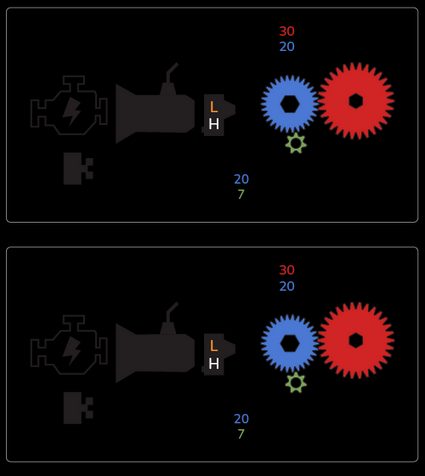Crawl Ratio Calculator
Use this crawl ratio calculator to determine your drivetrain ratio using transmission gear ratio, transfer case gear ratio, and axle gear ratio. If you're also interested in how to find axle gear ratio, you can check our intuitive axle gear ratio calculator. You will also learn what a good crawl ratio for your car is. Want to make sure you succeed off-road? If yes, figuring out your vehicle's crawl ratio is a good start.
What is the crawl ratio?
The crawl ratio determines the number of turnings the engine has to make to rotate the tire one complete revolution. If you know the crawl ratio, you can predict how your four-wheel-drive vehicle will perform in different conditions.
A higher crawl ratio means you will have more control of the vehicle off-road or when going over obstacles, while a lower crawl ratio is useful for everyday driving. You can find the overall power of your vehicle's engine using our horsepower calculator.
Formula how to calculate crawl ratio
The mathematical formula for the crawl ratio is simple. You just need to know for your vehicle:
- Transmission gear ratio (TG);
- Transfer case gear ratio (TCR); and
- Axle gear ratio (AGR)
Then multiply these values together:

What is a transmission gear ratio?
The transmission of your vehicle contains variously sized, toothed gears that can work together despite their different sizes to produce torque. Therefore, gear ratio refers to the ratio of the sizes of the associated gears. When different-sized gears mesh with each other, they can rotate at different speeds and deliver different amounts of power.
In the formula for the crawl ratio, it is sufficient for us to know the transmission first gear ratio (TG). This is the largest gear in the transmission connected to the small gear, and the typical gear ratio when the car is in first gear is 3.166:1.
If you are interested in calculating the rotation speed of your vehicle or other machine tools, you can check speeds and feeds calculator.
What is a transfer case gear ratio?
Transfer case gear ratio (TCR) informs how many times the front and rear transfer case outputs rotate per each revolution of the transmission output shaft. When the ratios in the low range vary from about 2:1 to about 4:1, the road speed in the low range is reduced by half or a quarter. This indicates that we have gained an increase in torque while reducing speed.
You can find the relationship between a vehicle's speed and its engine's RPM in rpm calculator.
What is an axle gear ratio?
The axle (or differential) gear ratio is the ratio of the ring gear’s teeth divided by the number of the pinion’s teeth. If, for example, you have an AGR of 3.51, you can use the notation 3.51:1 or simply 3.51, as both forms are technically correct. You can also smoothly check axle gear ratio using this embedded differential gear ratio calculator.
How to use crawl ratio calculator
To calculate the crawl ratio, you only need to determine a few parameters:
-
Enter your transmission gear ratio.
-
Enter your transfer case gear ratio.
-
Enter your axle gear ratio. If you do not know this value, count the number of teeth on the ring gear and the pinion.
-
Our axle gear ratio calculator will give you the desired crawl ratio value.
FAQs
How do I calculate the crawl ratio?
The crawl ratio is calculated by multiplication of the transmission gear ratio, transfer case ratio, and axle gear ratio (ratio of ring and pinion teeth).
If we have Ford C4 with a 1st gear transmission ratio of 2.46:1, transfer case gear ratio of 2.72, and axle gear ratio of 3.73:
- Enter 1st gear transmission ratio, transfer case gear ratio, and axle gear ratio into our calculator.
- Multiply their values together.
The overall crawl ratio will be:
Crawl Ratio = 2.46 × 2.72 × 3.73 = 25:1
How do I find axle gear ratios?
Here you will find two ways to calculate the axle gear ratio:
-
Method 1: Count the number of teeth on the ring gear and the pinion. Enter them into our differential gear ratio calculator to find your final axle gear ratio.
-
Method 2: Check the axle ratio on a sticker located on the outside of your model.
What is a typical crawl ratio?
Typically, the crawl ratio on cars used for daily driving range from 20:1 to 30:1. For four-wheel drive cars for general use, the ideal crawl ratio is approximately 50:1.
What is a good crawl ratio for my activity?
Typical crawl ratios for the most common activities are as follows:
-
Under 50 — Most factory settings fall within this range.
-
50-60 — Road and light trail riding.
-
80-90 — Handle the obstacles on an intermediate trail ride.
-
110-130 — Extreme off-road.
-
Over 130 — Excessive with little or no added benefit.
If you know the crawl ratio of your off-road vehicle, you can get an indication of the performance of your off-road vehicle. As you can see, to overcome obstacles without any difficulty, you need to set a higher crawl ratio.
A lower crawl ratio is suitable for normal driving, but if you want to go off-road, you should choose a higher value.
Does tire size affect crawl ratio?
Note that in our formula gear ratio of a vehicle is independent of the tire size or dimensions of the road wheels. Therefore, using a different size tire on the same vehicle does not affect the crawl ratio.
However, the larger the tire, the lower the output force on the driving wheels and the acceleration of the rotating wheels appears. Therefore, smaller tires will be more effective when driving over obstacles at a given crawl rate.